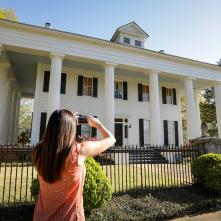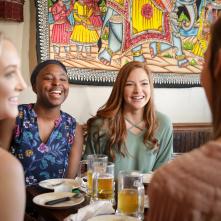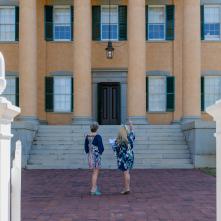Flannery O'Connor's Andalusia gets an update
By SUZANNE VAN ATTEN
Atlanta Journal-Constitution May 24, 2014
MILLEDGEVILLE, Ga. -- As soon as you turn off I-20 about an hour east of Atlanta, everything changes. In the time it takes to say, "Are we there yet?" the high-density, traffic-clogged ways of city life yield to a world that appears on the surface unchanged for the past 100 years.
Heading south on U.S. 441, the land opens up and flattens out. Pecan orchards and dairy farms stretch across the horizon. Small fishing ponds wink in the sun beside pine trees draped in purple wisteria. Tucked in the shadow of ancient oaks are wooden farmhouses and brick ranches, some advertising taxidermy services and deer processing.
A series of hand-painted signs tacked up every few yards hawk the sale of honey, cider, peches (sic) and hot peanuts. And then there are the churches, so many churches, mostly Baptist.
Flannery O'Connor country
The sign is so small it's easy to miss the right turn into Andalusia, the author's home her last 13 years of life. Most famously, it is where she wrote her celebrated Southern Gothic stories about sinners, fools and charlatans. Her best-known work is the perennial high school English class favorite, "A Good Man Is Hard to Find," in which a squabbling family takes a road trip to Florida and encounters a psychopath along the way. A devout Catholic who never married, O'Connor infused her work with death and violence, but faith and redemption, too.
O'Connor lived at Andalusia with her mother, Regina, who ran the 544-acre dairy farm. Every day she attended mass in Milledgeville, and from 9 a.m. to noon, she pecked out her stories on a typewriter in her bedroom -- her back to the window to prevent distraction and take advantage of the natural light.
For lunch she and her mother would go to the now-closed Sanford House, where she dined on roast beef and peppermint pie, and then she'd return home to nap, read and receive visitors.
O'Connor suffered from lupus (an autoimmune disease that took her life at age 39 in 1964), so her physical activity was limited. But she enjoyed spending time with her beloved peacocks and peahens that roamed the property. And when 5 p.m. struck, a round of gin martinis was served. It was a way of life as steeped in Southern tradition as a pitcher of sweet tea.
So the irony that a self-proclaimed "city girl" from Boston -- an art historian who is more of an expert in environmental sustainability than literature -- has been named executive director of the Flannery O'Connor-Andalusia Foundation does not go unnoticed.
Nevertheless, Elizabeth Wylie appears to have several things in her favor.
One, she has a jovial disposition, a hearty laugh and a penchant for storytelling, as though to the Southern manner born. Two, for the
position of operations manager, she hired April Moon Carlson, a Carrollton native with a master's degree in public history from the University of West Georgia and a fount of O'Connor knowledge. And three, she has experience in museum management from the Rhode Island School of Design Museum and Tufts University Art Gallery.
She also worked in business development for a couple of architecture firms, and, along with coauthor Sarah Sutton Brophy, wrote the book "The Green Museum: A Primer in Environmental Sustainability."
Preservations, conservation
Wylie arrived four months ago, following the departure of long-time director Craig Amason. Among her first tasks was installing vintage lawn chairs under shade trees in the backyard by the peafowl pen and removing a massive water oak in the backyard that hung perilously low over the main house.
"It's a preservation story as well as a conservation story," Wylie likes to say about her mission at Andalusia. She points to facets of the site besides O'Connor's legacy worthy of preserving and promoting, such as the history of farming in Middle Georgia and the challenges of a single woman running a business in that era.
"The preservation of lifeways -- I am very keen on that," she says.
And then there is the property -- 544 acres of virgin wooded land, home to bobcats, wild turkeys, deer, snakes, lizards and turtles.
"The idea of being outside is something that's lost," Wylie says. "We're raising generations of people who never go outside. I was thinking about these kids who spend a lot of time indoors in front of screens, like personal devices or in the back of the van with the DVD player. I'm interested in seeing how we can connect these kids with nature."
Imagaining the future
As she strolls around the property, pointing out the newly restored cow barn and the Hill House, where tenant farmers once lived, Wylie sees not just what's there, but what could be there one day. She imagines a large space behind the cow barn where visitors can linger to read or write or just soak up the sun and natural beauty. In the small calving barn tucked back in the woods she visualizes an artists' retreat. In the empty stables, she sees children taking horseback-riding lessons.
"I'm a big brainstormer," Wylie says. "So I might mention to somebody, 'Wouldn't it be kind of interesting to have a micro distillery here for gin?' just because I'm thinking about ways we can use our major asset -- the land and the Flannery O'Connor brand. So I just brainstorm a lot and then I think, oh my gosh, people are going to run to town and say they've got a still out there!"
In addition to preserving Andalusia, Wylie's goal is to see that it generates money. The historic site has no endowment; the foundation survives solely on donations. Its operating budget for 2014 is a mere $200,000.
"I've got a lot of ideas, but, of course, the proof is in the pudding what we're able to make work, and that's all about collaboration and people and funding and supporters," she says.
This year, Wylie is focused on opening the cow barn to the public May 1 and the Hill House later this summer, and also strategizing Andalusia's future. Next year will be the year for new initiatives, she hopes.
And there is that little issue of acclimating to life in Middle Georgia. Wylie likes to tell a story about the day a workman on the property stopped her as she passed by.
"He said, 'This place is so pretty, you should have w'dins.' And I said, 'What?' And he said, 'W'dins.' 'What?' 'W'dins!' It took three times for me to understand he was saying 'weddings,'" she says with a guffaw.
Meanwhile, Wylie has the daunting responsibility of stewarding the personal possessions that still fill the cupboards, pantries and dressers inside the 19th century, two-story clapboard farmhouse.
She walks through the screen porch that stretches the length of the house and turns left into the author's bedroom, which looks much like it did the day she died, except the bookshelves are empty and her desk and typewriter have been replaced with replicas.
The originals are displayed in the Flannery O'Connor Room at Georgia College & State University in town.
Wylie gingerly opens the chifferobe door to reveal O'Connor's floral print shirtwaist dresses still hanging inside. She pulls open a drawer and plucks out a black pump, looks at it, puts it back.
She starts to open another drawer, but decides against it. "What am I going to do with Flannery's unmentionables?" she wonders aloud before filling the high-ceilinged room with laughter.
 Things To Do
Things To Do
 Events
Events
 Food & Drink
Food & Drink
 Hotels & Lodging
Hotels & Lodging
 Plan Your Trip
Plan Your Trip

